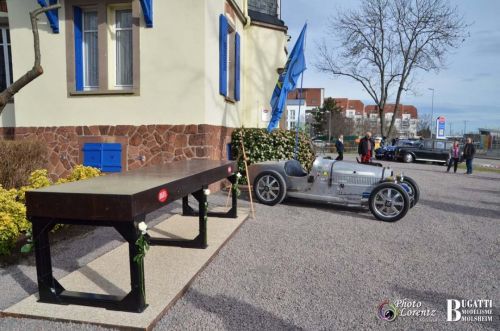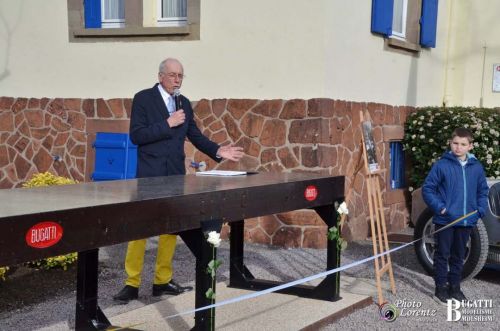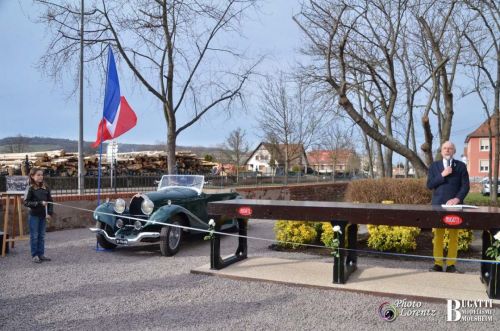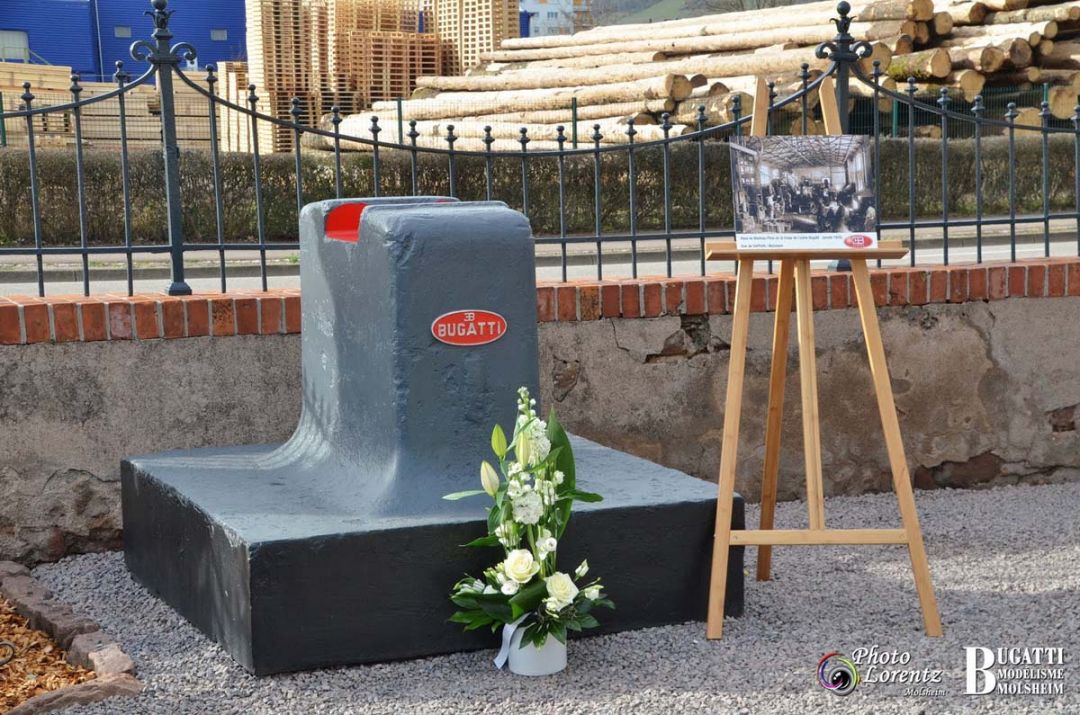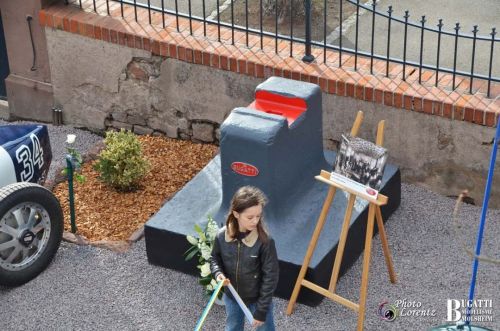Marbre et marteau pilon
-

Marbre
Le marbre de traçage et de contrôle Bugatti (1920/1930)
Pièce emblématique offerte par l'usine MESSIER-BUGATTI (denenue SAFRAN)sur proposition du directeur de site de l'époque M. Marcel SCHOTT
Généralement composé d'une plaque en fonte ou en granit, sa surface parfaitement plane a de multiples applications pratiques. Poids : 2860 kg.
Cet outil de précision permet :
-
- - de vérifier la planéité d'une surface
- - des contrôles métrologiques ou de concentricités
- - des applications de traçages comme :
- le traçage en vue de perçage sur pièce à usiner
- le traçage pour la répartition des zones bruts par rapports à l'usinage prévu...
Différents enduits utilisés pour visualiser le tracé : Sulfate de cuivre, Chromate de zinc ou du bleu de Prusse pour visualiser et vérifier une planéité.
- Outils complémentaires :
- Outils de traçages : trusquin à tracer - Pointe à tracer - Pointeau
- Outils de métrologie : Comparateur mobile sur pied - cales étalon - Equerre - Vé Cube...
La restauration, la confection du support, ainsi que l'implantation au parc de l'Hostellerie du Pur sang, siège des Enthousiastes Bugatti, à été réalisée par les établissements FRIEDERICH de Mollkirch en février 2020.
Werkbank zur Kontrolle und zur Markierung
Ikonisches Werkzeug vom MESSIER-BUGATTI Werk (heute SAFRAN) auf Vorschlag des damaligen Standortleiters Marcel SCHOTT den EBA übergeben.
Im Allgemeinen bestehend aus einer Platte aus Gusseisen oder Granitstein. Das Besondere ist die perfekt ebene Oberfläche, die für viele pratische Anwendungen verwendet wird. Gewicht: 2860 kg.
Dieses Präzisionswerkzeug ermöglicht :
die Ebenheit einer Oberfläche zu überprüfen.
Durchführungmesstechnischer oder Konzentrischer Kontrollen.
Markierungen durch zu führen :
Markieren zum Bohren von Werkstücken
Markierungen für die Verteilung der Roh-Zonen im Verhältnis zu geplanten Bearbeiteung usw...
Verschiedene Überzüge zur Visualisierung der Markierungen :
Kupfersulfat, Zinkchromat oder Preußschblau zur Visualisierung und Überprüfung der Ebenheit.
Ergänzende instrumente
Markierung-Werkzeuge : Trusquin - Anreißspitze - Nadel usw...
Messwerkzeuge : Mobiler Standkomparator - Eichkeile - Winkel - Vé WÜrfel usw...
Die Restaurierung, die Herstellung der Träger, sowie die Aufstellung im Park, des Pur sang, Sitz der Bugatti-Enthusiasten, wurde im Februard 2020 von dem FRIEDERICH Betrieb in Mollkirch realisiert.
Tracing and Controlling plate
Iconic piece donated by the MESSIER-BUGATTI factory (now SAFRAN) at the suggestion of the site manager at the time, Mr Marcel SCHOTT.
Generally composed of a cast-iron or granite plate, its perfectly flat surface has many practical applications. Weight: 2860 kg.
This precision tool can be used to
checking the flatness of a surface
metrological or concentricity checks
marking applications such as :
tracing for drilling on workpieces
tracing for the distribution of rough areas in relation to the planned machining...
Various coatings used to visualise the tracing: copper sulphate, zinc chromate or Prussian blue to visualise and check flatness.
Additional tools :
Scribing tools: scribing jig - Scribing point - Punch
Metrology tools: mobile comparator on stand - gauge blocks - square - Vé Cube, etc.
The restoration and manufacture of the stand, as well as its installation in the grounds of the Hostellerie du Pur Sang, headquarters of the Enthousiastes Bugatti, was carried out by the FRIEDERICH company in Mollkirch in February 2020.
Base du marteau pilon de la forge
Base du marteau - pilon de la forge de l'usine Bugatti (1920)
Pièce emblèmatique offerte par l'usine MESSIER-BUGATTI (devenue SAFRAN) sur proposition du directeur du site M. Marc SCHOTT.
Fonctionnement
Le pilon (marteau) est fixé à l'extrémité d'une longue planche en bois, en position verticale, deux glissières latérales en acien servent de guides au pilon.
En partie haute, deux rouleaux entraineurs, tournants en sens inverse, sont positionnés de part et d'autre de la planche.
Soulèvement du pilon
Les rouleaux entraineurs sont mis en contact avec la planche, celle-ci prise en sandwich, est soulevée entrainant le pilon vers le haut.
La frappe
L'écartement desrouleaux libère la planche, provoquant la chute du pilon vers l'enclume. La force de frappe peut-être ajustée, en variant la hauteur de chute du pilon.
Le socle support de l'enclume du grand marteau pilon est une pièce volumineuse pesant 3860 kg, dont les deux tiers de la base étaient enfouis dans la dalle bétonnée du sol de l'atelier.
Der großer Hammer
Ikonisches Werkzug vom MESSIER-BUGATTI Werk (heute SAFRAN), auf Vorschlag des damaligen Standortleiter Herrn Marcel SCHOTT den EBA übergeben.
Funktionsweise
Der Stößel ist an einem Hotzbrett befestig und in vertikaler Position aufgehängt. Zweiseitliche Stahlschienen dienen ihm als Führung. An der Oberseite, definden sich 2 Antriebsrollent, die sich jeweils in umgekehrter Richtung drehen und auf beiden Seiten des Brettes positionnert sind, ohne diese jedoch zu berühren.
Heben des Stößels
Wenn die Antriesrollen in Kontakt gebracht, wird das Brett eigeklemmt und ihre Drehung fördert den Stößel nach oben.
Der Schlag
Wenn die Antriebsrollen auseinandergebracht werden, befrien sie das Brett, so dass der Stößel, durch die Schwerkraft in Richtung des Ambosses fällt. Die Schlagkraft konnte geändert werden durch die Anpassung der Fallhöhe des Stößels.
Drei Viertel des Amboss Volumen der 3860 kg wiegt, waren im Betondoden der Werkstatt vergraben.
The big hammer
An emblematic piece donated by the MESSIER-BUGATTI factory (now SAFRAN) at the suggestion of site manager Marc SCHOTT.
How it works
The pestle (hammer) is fixed to the end of a long wooden board, in a vertical position, with two old-fashioned side guides.
At the top, two drive rollers, rotating in opposite directions, are positioned on either side of the board.
Lifting the rammer
The drive rollers are brought into contact with the board, which is then lifted up, pulling the rammer upwards.
Striking
The spreading of the rollers releases the board, causing the rammer to fall towards the anvil. The striking force can be adjusted by varying the height at which the pestle falls.
The base supporting the anvil of the large drop hammer is a bulky piece weighing 3860 kg, two-thirds of the base of which was buried in the concrete slab on the workshop floor.

